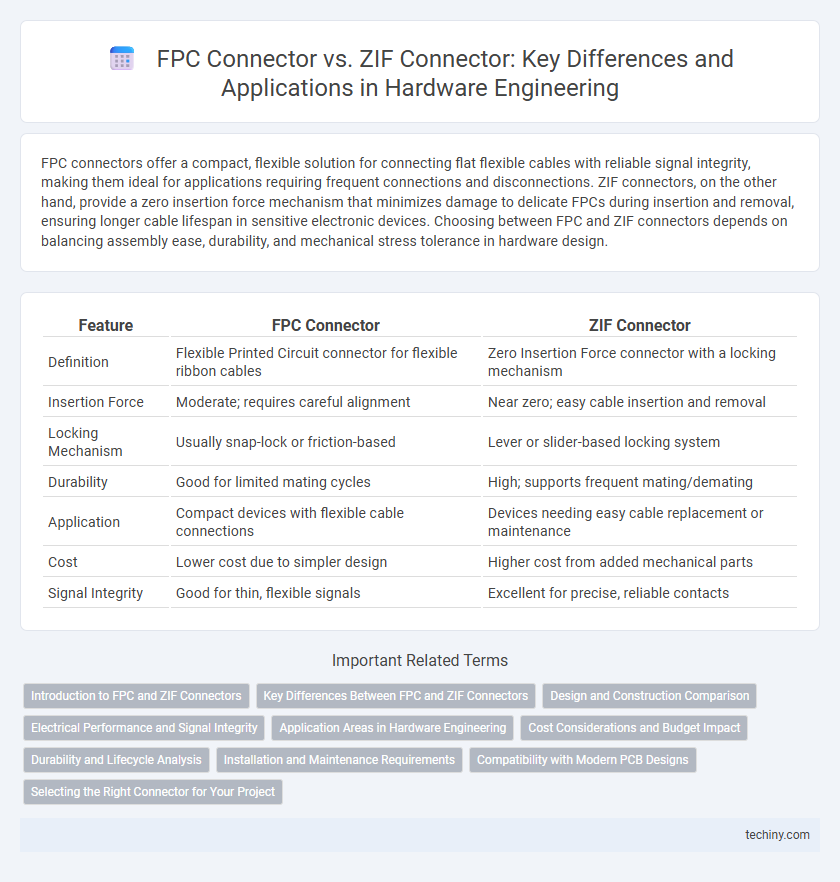FPC connectors offer a compact, flexible solution for connecting flat flexible cables with reliable signal integrity, making them ideal for applications requiring frequent connections and disconnections. ZIF connectors, on the other hand, provide a zero insertion force mechanism that minimizes damage to delicate FPCs during insertion and removal, ensuring longer cable lifespan in sensitive electronic devices. Choosing between FPC and ZIF connectors depends on balancing assembly ease, durability, and mechanical stress tolerance in hardware design.
Table of Comparison
| Feature | FPC Connector | ZIF Connector |
|---|---|---|
| Definition | Flexible Printed Circuit connector for flexible ribbon cables | Zero Insertion Force connector with a locking mechanism |
| Insertion Force | Moderate; requires careful alignment | Near zero; easy cable insertion and removal |
| Locking Mechanism | Usually snap-lock or friction-based | Lever or slider-based locking system |
| Durability | Good for limited mating cycles | High; supports frequent mating/demating |
| Application | Compact devices with flexible cable connections | Devices needing easy cable replacement or maintenance |
| Cost | Lower cost due to simpler design | Higher cost from added mechanical parts |
| Signal Integrity | Good for thin, flexible signals | Excellent for precise, reliable contacts |
Introduction to FPC and ZIF Connectors
FPC (Flexible Printed Circuit) connectors are designed to connect flexible flat cables to printed circuit boards, enabling compact and lightweight electronic assemblies often used in mobile devices and wearables. ZIF (Zero Insertion Force) connectors facilitate easy insertion and removal of flat flexible cables without applying pressure, reducing wear and improving reliability in sensitive electronic equipment. Both connector types are crucial for high-density interconnections in hardware engineering, supporting miniaturization and enhanced device performance.
Key Differences Between FPC and ZIF Connectors
FPC connectors are designed for flexible printed circuits with a focus on compact size and reliability in low-profile applications, while ZIF connectors emphasize zero insertion force to protect delicate contacts during cable insertion and removal. FPC connectors rely on friction or locking mechanisms to secure the cable, whereas ZIF connectors utilize a locking latch or slider to firmly clamp the flat flexible cable without damage. The choice between FPC and ZIF connectors is typically driven by the application's demand for assembly ease, durability, and maintenance frequency.
Design and Construction Comparison
FPC connectors feature a compact design with a simple flip-lock or slide-lock mechanism, enabling secure connections for flexible printed circuits with a low profile ideal for space-constrained applications. ZIF connectors utilize a zero-insertion-force design with a lever or slider that gently clamps the flat cable, minimizing wear on delicate conductors and ensuring reliable electrical contact over repeated cycles. The construction of FPC connectors emphasizes minimal footprint and ease of assembly, while ZIF connectors prioritize durability and cable retention through precise mechanical locking structures.
Electrical Performance and Signal Integrity
FPC connectors offer reliable electrical performance with minimal contact resistance, supporting high-frequency signal transmission ideal for compact, flexible circuits. ZIF connectors provide exceptional signal integrity through zero insertion force contacts, reducing wear and mechanical stress that can degrade electrical connections over time. Both connectors are engineered to maintain consistent impedance and minimize crosstalk, but ZIF connectors excel in applications requiring frequent mating cycles and superior long-term signal stability.
Application Areas in Hardware Engineering
FPC connectors are widely used in compact electronic devices such as smartphones, tablets, and laptops due to their flexibility and ability to handle fine-pitch connections. ZIF connectors are preferred in hardware applications requiring frequent connection and disconnection, like testing equipment and modular circuit boards, where secure locking mechanisms prevent damage to delicate flat cables. Both connectors serve critical roles in ensuring reliable signal transmission in consumer electronics, medical devices, and automotive control systems.
Cost Considerations and Budget Impact
FPC connectors generally offer a lower upfront cost compared to ZIF connectors, making them suitable for budget-sensitive hardware projects. However, ZIF connectors can reduce assembly labor costs due to their tool-free insertion mechanism, potentially lowering total production expenses over time. Evaluating the trade-off between initial component price and long-term savings is crucial for optimizing budget allocation in hardware engineering designs.
Durability and Lifecycle Analysis
FPC connectors offer moderate durability with typical lifecycle ratings around 500 to 1,000 mating cycles, making them suitable for applications with infrequent connections. ZIF connectors provide superior durability, often exceeding 10,000 insertion cycles due to their zero insertion force mechanism, which reduces mechanical stress on the contacts. Lifecycle analysis highlights ZIF connectors as more reliable for frequent mating and demating in hardware systems requiring long-term durability.
Installation and Maintenance Requirements
FPC connectors require precise alignment and careful insertion to prevent damage to the flexible printed circuit, demanding skilled personnel for installation and regular inspection to ensure reliable connections. ZIF connectors feature a locking mechanism that simplifies insertion and removal of the flexible circuit, reducing mechanical stress and minimizing the risk of damage during maintenance. Their design enables faster assembly and easier repair processes, making ZIF connectors preferable for applications with frequent maintenance cycles.
Compatibility with Modern PCB Designs
FPC connectors offer superior compatibility with modern PCB designs due to their slim profile and flexible tail, enabling compact and high-density circuit layouts. ZIF connectors excel in applications requiring repeated cable insertions and removals, but their larger footprint and locking mechanism may limit their use in space-constrained PCBs. Selecting between FPC and ZIF connectors depends on the balance between mechanical durability and the need for compact, high-performance PCB integration.
Selecting the Right Connector for Your Project
FPC connectors offer a compact, reliable solution for flexible printed circuits, ideal for high-density and space-constrained applications, while ZIF connectors provide easy insertion and removal with a locking mechanism, reducing wear and increasing longevity in frequent connection cycles. Consider factors such as mechanical durability, mating cycles, space constraints, and electrical performance when selecting between FPC and ZIF connectors. Evaluating the specific requirements of your project ensures the chosen connector optimizes signal integrity and assembly efficiency.
FPC Connector vs ZIF Connector Infographic

 techiny.com
techiny.com